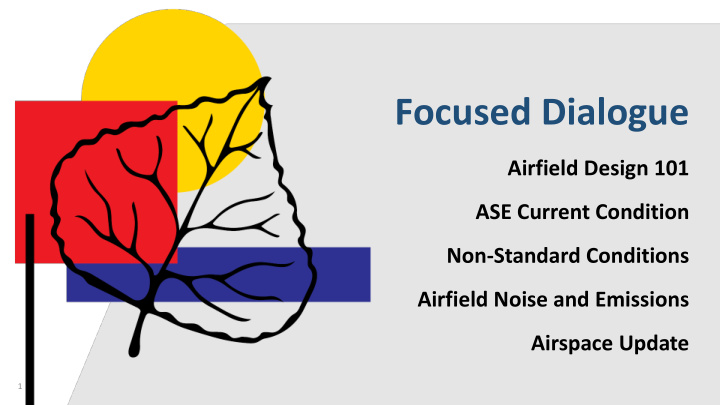



Focused Dialogue Airfield Design 101 ASE Current Condition Non-Standard Conditions Airfield Noise and Emissions Airspace Update 1
Airfield Design 101 2
Airfield Design 101 I. Public Use Airports Subject to FAA Design Standards • Safety • Consistency across national network • Preservation of public investment II. Guiding Documents • Advisory Circulars • Orders • Technical Guidance III. AC 150/5300-13A, Airport Design • Airfield geometric and grading standards 3
Airfield Design 101 I. Runway Safety and Object Free Areas • Aircraft approach speed – Aircraft Approach Category (AAC) • Aircraft wingspan – Airplane Design Group (ADG) II. Runway to Taxiway Separation • Runway centerline to taxiway centerline • Runway centerline to holding aircraft • Runway centerline to parked aircraft III. Taxiway Safety and Object Free Areas • Aircraft wingspan – Airplane Design Group (ADG) 4
RSA, ROFA, TSA and TOFA 5
ASE Airfield Current Condition 6
ASE Airfield Current Condition I. Modified Runway Design Code, D-III II. Geometric Modifications of Standards • Runway to taxiway separation = 320’ vs. 400’ - 95’ wingspan restriction • Runway to aircraft hold line = 272.5’ vs. 329’ • Runway object free area - Taxiway A North - West side of runway • Taxiway object free area, east side = 76.5’ vs. 96’ - 95’ wingspan restriction III. Grading Modifications of Standards • Runway safety area – drainage swales within RSA and grades that slope toward runway • Runway object free area – west side of runway 7
ASE Airfield Current Condition IV. Temporary vs. Permanent Modifications of Standards • 13 Modifications of Standards listed on ALP • 5 to be corrected with EA scoped project • 8 to remain – runway, taxiway and apron surface gradients V. Non-Standard Conditions Evaluation (Kimley-Horn) • 14 additional non-standard conditions identified • Multiple locations of the 27 results in 85 non-standard issues 8
9
ASE Non- Standard Conditions 10
ASE Non-Standard Conditions I. EA Project – Airfield Standardization II. Critical Elements • Runway/taxiway separation - Move runway, taxiway or both - Primary constraints – Owl Creek Road and Taxiway A9 - Primary impacts – AOC and east side development • Runway safety area and object free area grading - Both sides of runway • Taxiway A object free area – apron side • Terminal apron grading – slope away from terminal (fire code) III. Other Considerations • FBO facilities – lease expires in 2023 • Air Traffic Control Tower – Age and best location • Potential westside development • Property east of Highway 82 11
ASE Non-Standard Conditions IV. Runway to Taxiway Separation • Owl Creek Road – Avoid impacts to open space • Taxiway A9 – Improve line of sight (hot spot) • AOC impacts V. Critical Elements • Runway/taxiway separation - Move runway, taxiway or both - Primary constraints – Owl Creek and Taxiway A9 - Primary impacts – AOC and east side development • Runway safety area and object free area grading - Both sides of runway • Taxiway A object free area – apron side • Terminal apron grading – slope away from terminal (fire code) 12
Owl Creek Road 13
Taxiway A9 – Runway 80’ West 14
Taxiway A9 – Runway 60’ West 15
Runway Shift 80’ West 16
AOC – Runway 80’ West 17
RSA Drainage and Grading 18
Taxiway A East Side TOFA 19
Taxiway A East Side TOFA 20
Taxiway A East Side TOFA 21
Terminal Apron - Grades 22
Airfield Noise and Emissions 23
Airfield Noise I. Potential Noise Reduction Measures • Electrified GSE and GPUs • Wired power and pre-conditioned air (no APU) • Encourage use of newer and quieter aircraft engines • Geothermal heated terminal apron pavement – less plowing • Landscaping berms • Sustainable design and construction practices 24
Airfield Emissions I. Potential Emissions Reduction Measures • Electrified GSE and GPUs • Wired power and pre- conditioned air (no APU) • LED lighting • Solar • Covered auto parking and hangars • PV panel arrays 25
Airfield Emissions I. Potential Emissions Reduction Measures (cont.) • Geothermal heated terminal apron pavement • Encourage use of newer and quieter aircraft engines • Geothermal heated terminal apron pavement – fewer plow ops 26
Recommend
More recommend